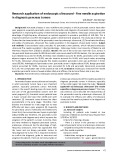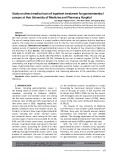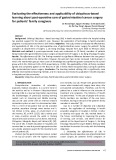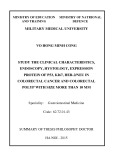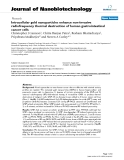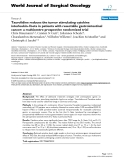
Gastrointestinal cancers
-
This study was aimed at: (1) To describe the characteristics of the pancreatic tumor by endoscopic ultrasound; (2) To evaluate the efficacy and safety of endoscopic ultrasound fine needle aspiration in the diagnosis of pancreatic tumors.
 7p
7p  viharuno
viharuno
 03-01-2025
03-01-2025
 1
1
 1
1
 Download
Download
-
Gastrointestinal cancers, including liver cancer, colorectal cancer, and stomach cancer, are the most common cancers in the world as well as in Vietnam, posing a leading threat to human health. The cost of treating these cancers is a major problem that burdens not only patients but also healthcare systems. The study aims to analyze treatment costs for the four most common types of gastrointestinal cancer nowadays.
 9p
9p  viharuno
viharuno
 03-01-2025
03-01-2025
 2
2
 1
1
 Download
Download
-
This study aimed to evaluate the effectiveness and applicability of UBL in the post-operative care of gastrointestinal cancer surgery for patients’ family caregivers at Department of Surgery 1, Da Nang Oncology Hospital from April 2020 to February 2022.
 7p
7p  viharuno
viharuno
 03-01-2025
03-01-2025
 1
1
 1
1
 Download
Download
-
Description of the clinical and anatomic morphology of nonepithelial gastrointestinal tract cancer; description of surgical methods and evaluation of surgical treatment results for non-epithelial gastrointestinal tract cancer.
 27p
27p  badbuddy10
badbuddy10
 21-04-2022
21-04-2022
 23
23
 2
2
 Download
Download
-
Objectives: To assess results of transanal total mesorectal excision laparoscopic surgery for treatment of the middle and low rectal cancer. Subjects and method: Clinical intervention, prospective, follow-up study without comparison in 45 patients with middle and low rectal cancer underwent transanal total mesorectal excision in Gastrointestinal Surgery Department, 108 Millitary Central Hospital, from July 2017 to August 2018.
 9p
9p  vixyliton2711
vixyliton2711
 17-04-2019
17-04-2019
 30
30
 2
2
 Download
Download
-
Study the clinical characteristics, endoscopy, histopathology, expression of proteins p53, Ki67, Her- 2/neu in colorectal cancer and colorectal polyps greater than or equal to 10 mm; study the relationship between the expression of proteins p53, Ki67 and Her- 2/neu with histopathological characteristics, lymph node metastasis in colorectal cancer and colorectal polyps greater than or equal to 10 mm.
 27p
27p  change04
change04
 08-06-2016
08-06-2016
 52
52
 4
4
 Download
Download
-
ADH1 and ADH4 are the major alcohol dehydrogenases (ADH) in ethanol and retinol oxidation. ADH activity and protein expression were investigated in rat gastrointestinal tissuehomogenates by enzymatic andWesternblot analyses. In addition, sections of adult rat gastrointestinal tract were examined byin situ hybridization and immunohistochem-istry.ADH1andADH4weredetectedalong thewhole tract, changing their localization and relative content as a function of the area studied.
 11p
11p  fptmusic
fptmusic
 16-04-2013
16-04-2013
 34
34
 2
2
 Download
Download
-
Tuyển tập báo cáo các nghiên cứu khoa học quốc tế ngành y học dành cho các bạn tham khảo đề tài: Intracellular gold nanoparticles enhance non-invasive radiofrequency thermal destruction of human gastrointestinal cancer cells
 9p
9p  toshiba25
toshiba25
 08-12-2011
08-12-2011
 56
56
 6
6
 Download
Download
-
Tuyển tập báo cáo các nghiên cứu khoa học quốc tế ngành y học dành cho các bạn tham khảo đề tài: Taurolidine reduces the tumor stimulating cytokine interleukin-1beta in patients with resectable gastrointestinal cancer: a multicentre prospective randomized trial
 13p
13p  matuot_238
matuot_238
 12-10-2011
12-10-2011
 58
58
 3
3
 Download
Download
CHỦ ĐỀ BẠN MUỐN TÌM








